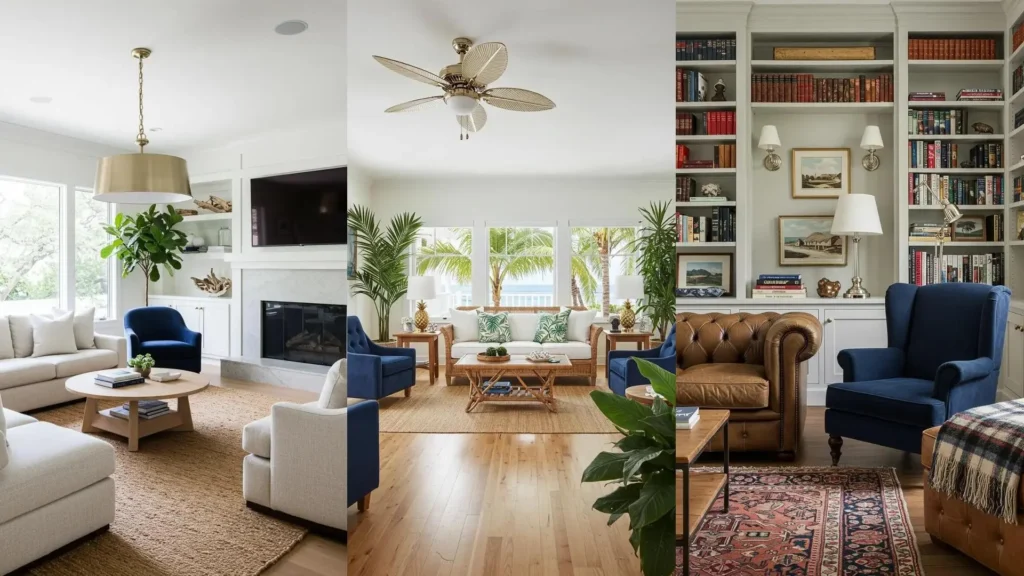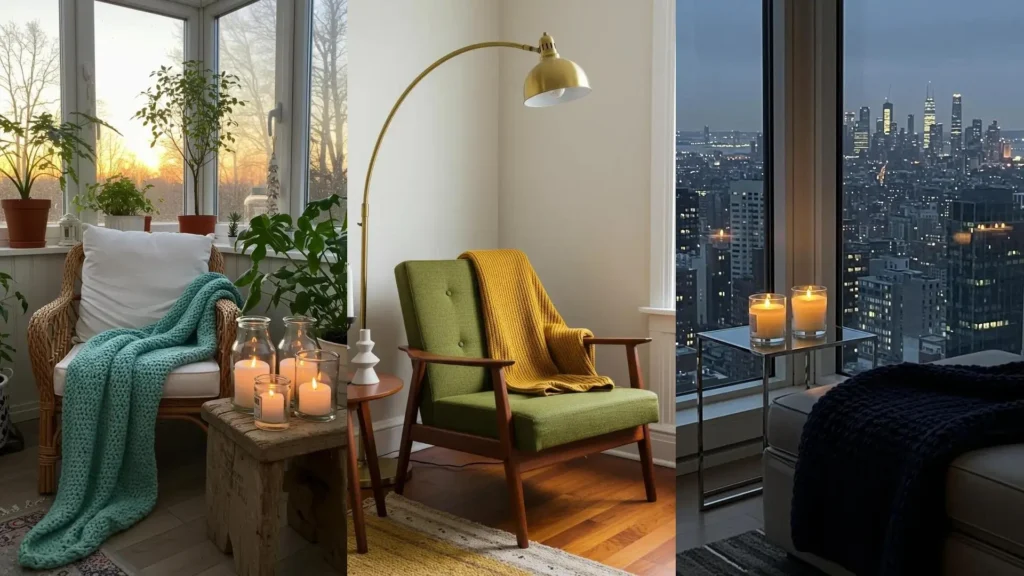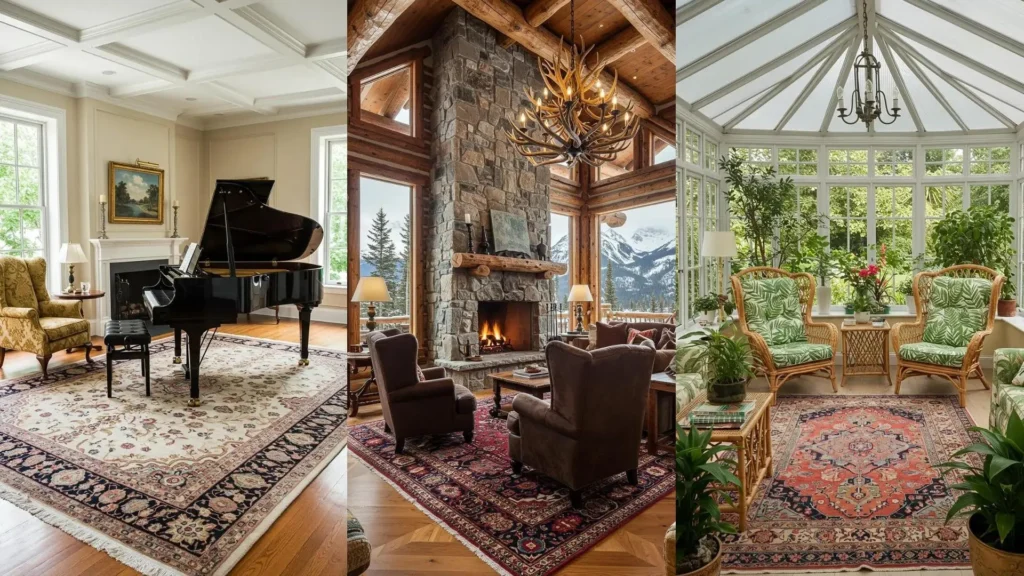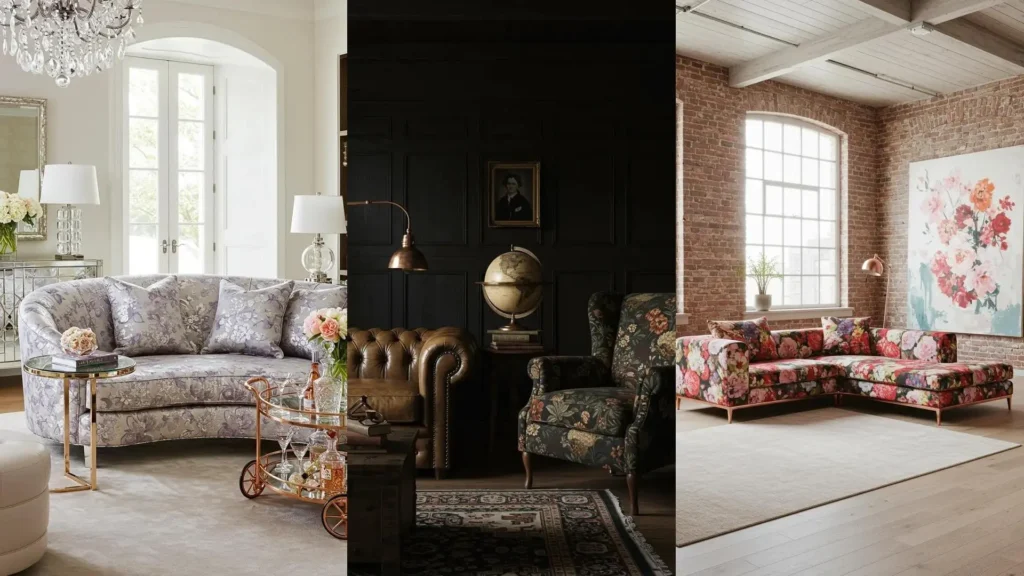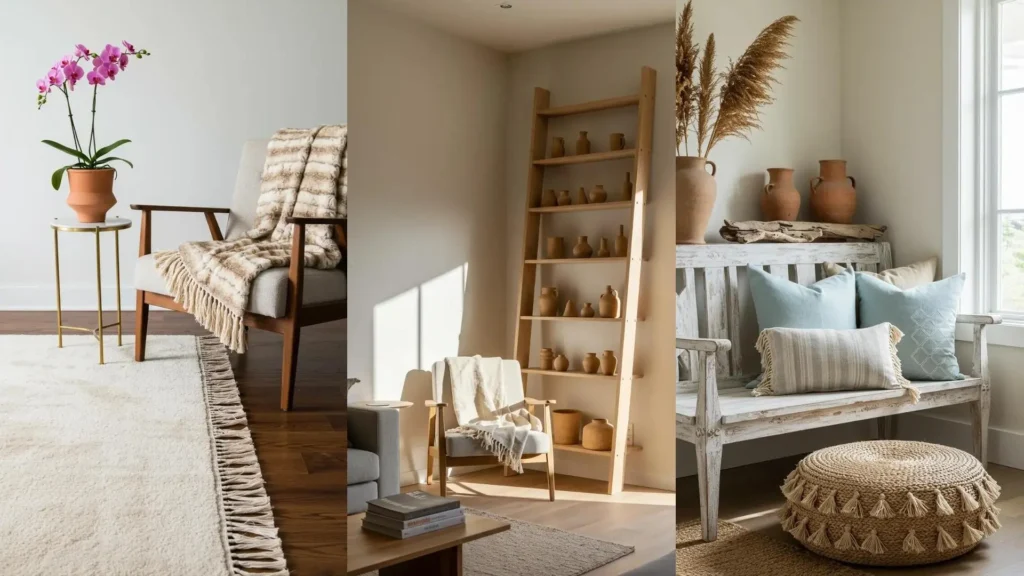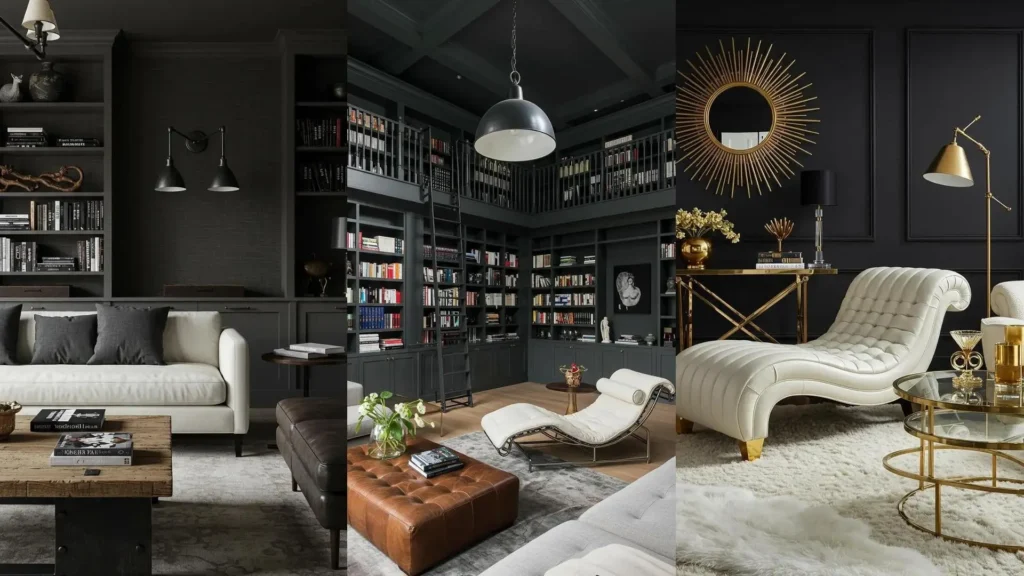Creating a home that feels like a true sanctuary—a place to unwind, recharge, and simply be—doesn’t require a complete overhaul.
It begins with intention.
The Scandinavian spa aesthetic is not about a strict set of rules, but a mindset. It’s about choosing materials that feel good to the touch, embracing the quiet beauty of natural light, and giving cherished objects room to breathe. By layering soft, natural textiles with the grounding weight of stone, you create a subtle, deeply calming sensory experience.
Think of these ideas not as a to-do list, but as gentle invitations to see your space differently. You can start right now, with a single, thoughtful addition.
1. Anchor with Natural Texture and Scale
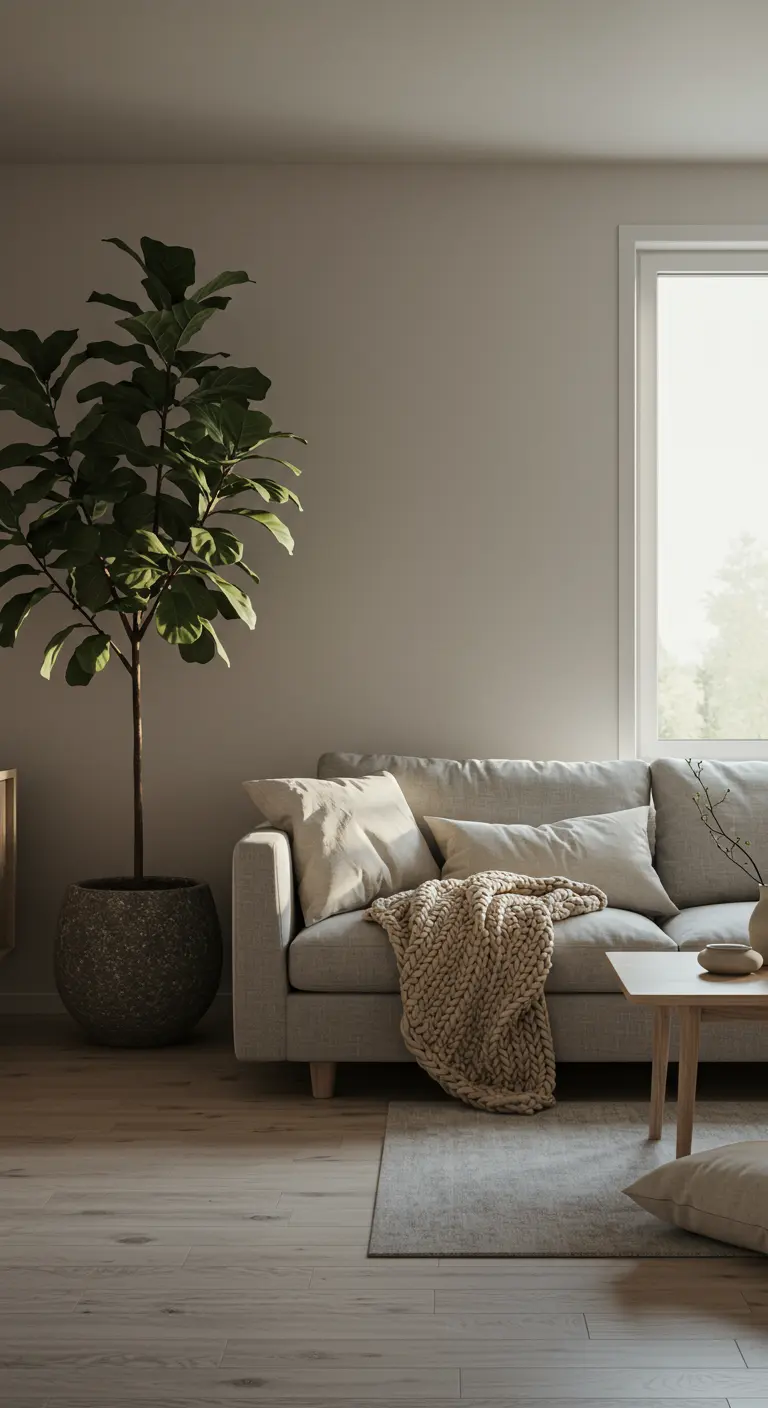
A substantial stone planter gives a plant architectural presence, acting as an anchor for the corner of a room.
Pair this solid element with a soft, chunky knit throw to create a tactile dialogue between hard and soft textures.
This simple contrast is what brings a neutral room to life, giving it depth and interest without adding clutter.
2. Define Zones with Natural Fiber Rugs
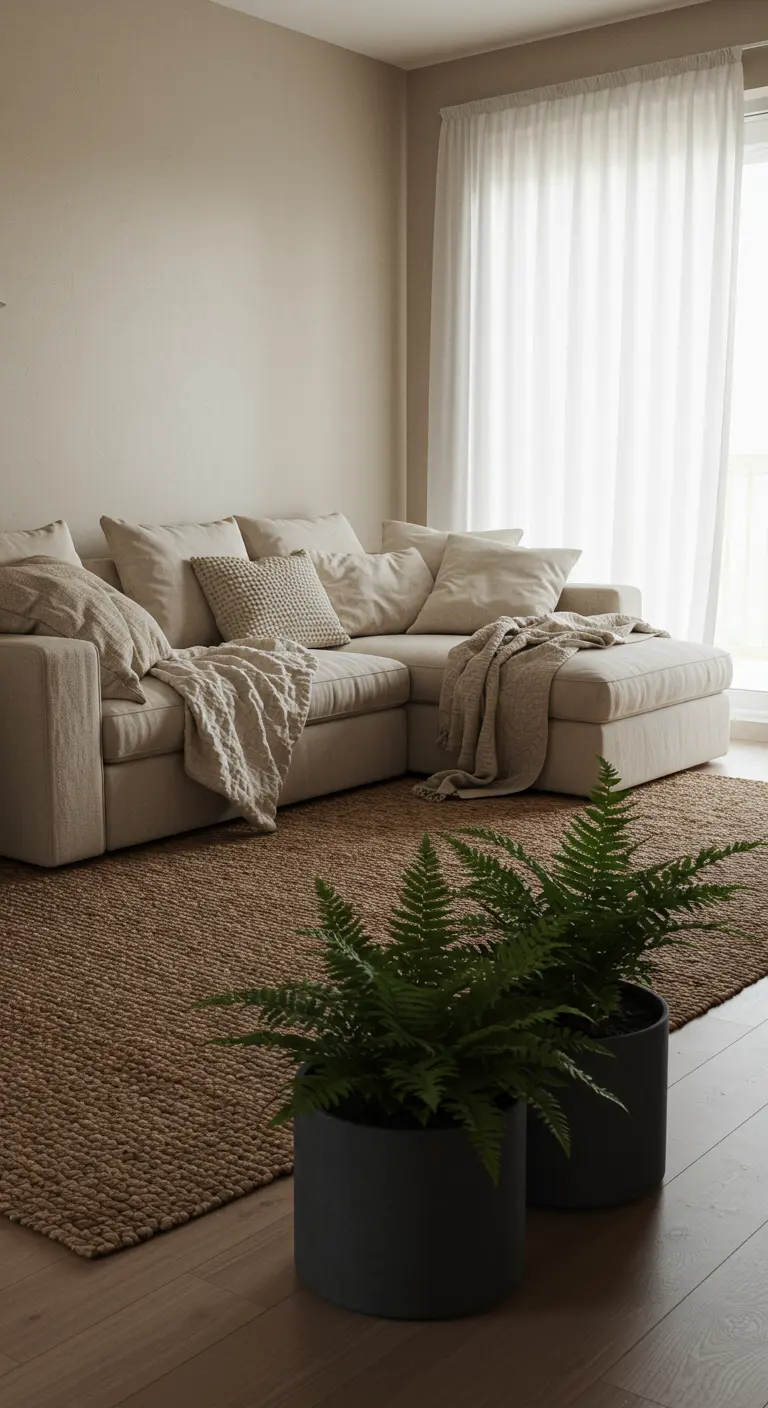
Use a large jute or sisal rug to create a distinct zone of warmth and texture, which instantly grounds a seating area and makes it feel more intimate.
Ensure the rug is large enough for the front legs of your furniture to rest on it, a key step that unifies the arrangement.
Pair it with sheer white curtains to diffuse sunlight, enhancing the soft, airy feel you’re aiming for.
This principle helps create timeless coastal interiors as well.
3. Introduce an Unexpected Metallic Accent
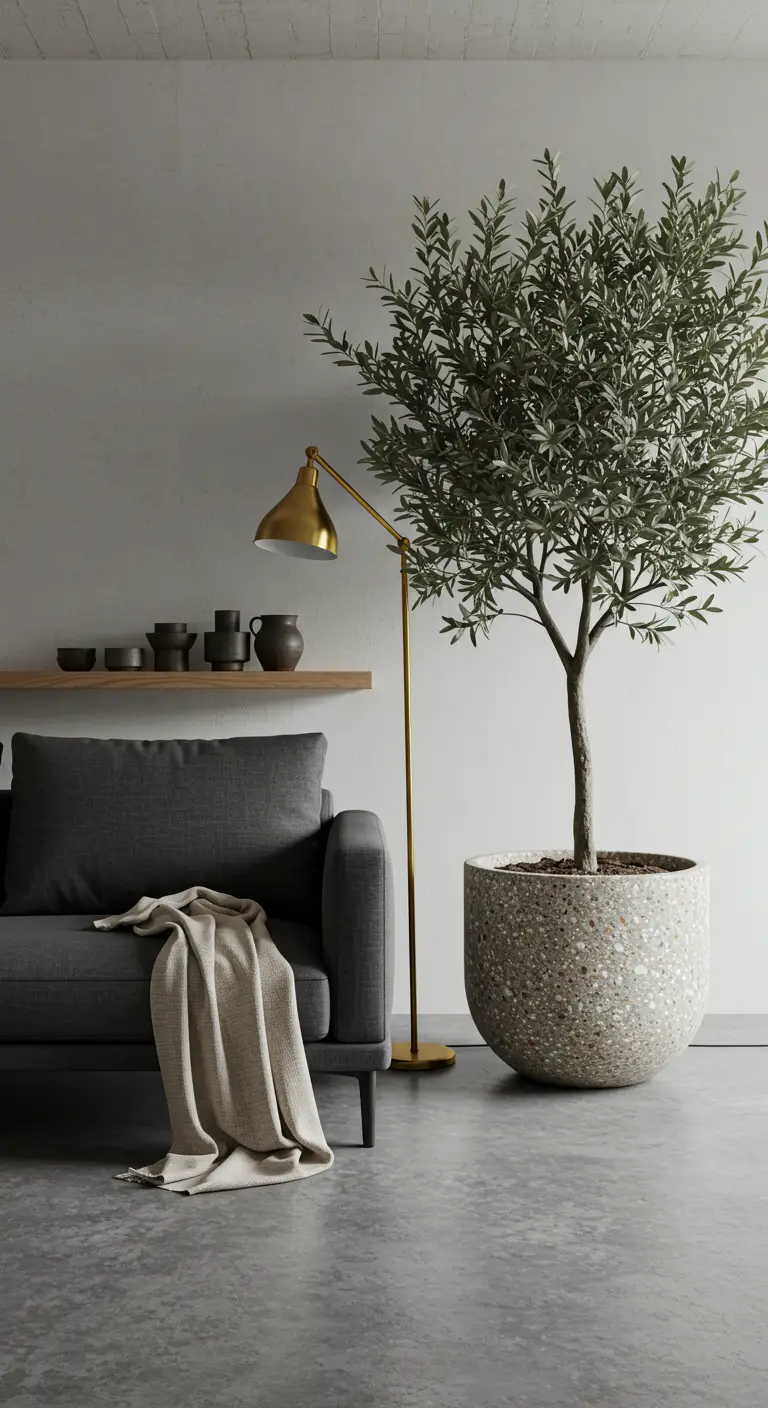
Even in a serene, minimalist space, a single metallic element can add a layer of sophistication.
A slender brass floor lamp contrasts beautifully with the raw, speckled finish of a terrazzo planter and the matte surface of a concrete floor.
This is not about adding clutter; it’s about a deliberate touch of warmth and reflective light that elevates the entire composition.
4. Layer Patterns in a Muted Palette
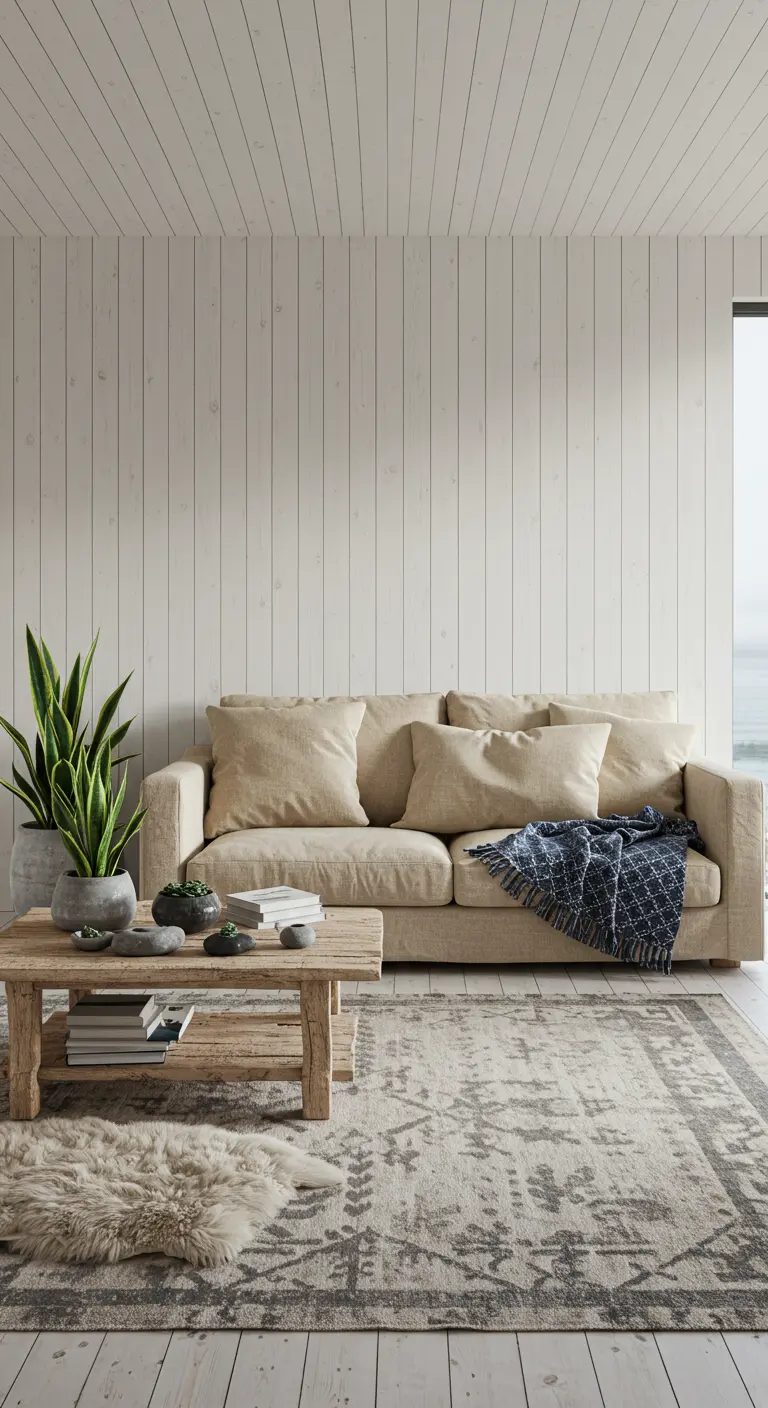
To create visual interest without overwhelming a neutral space, layer patterns of a similar tone.
Notice the subtle geometric rug, the texture of the sheepskin, and the weave of the throw. They all harmonize because the color palette is restrained.
This approach adds depth and a sense of history, making the room feel thoughtfully collected over time.
It’s a core principle in creating spaces with coastal minimalism.
5. Maximize Light with an All-White Backdrop
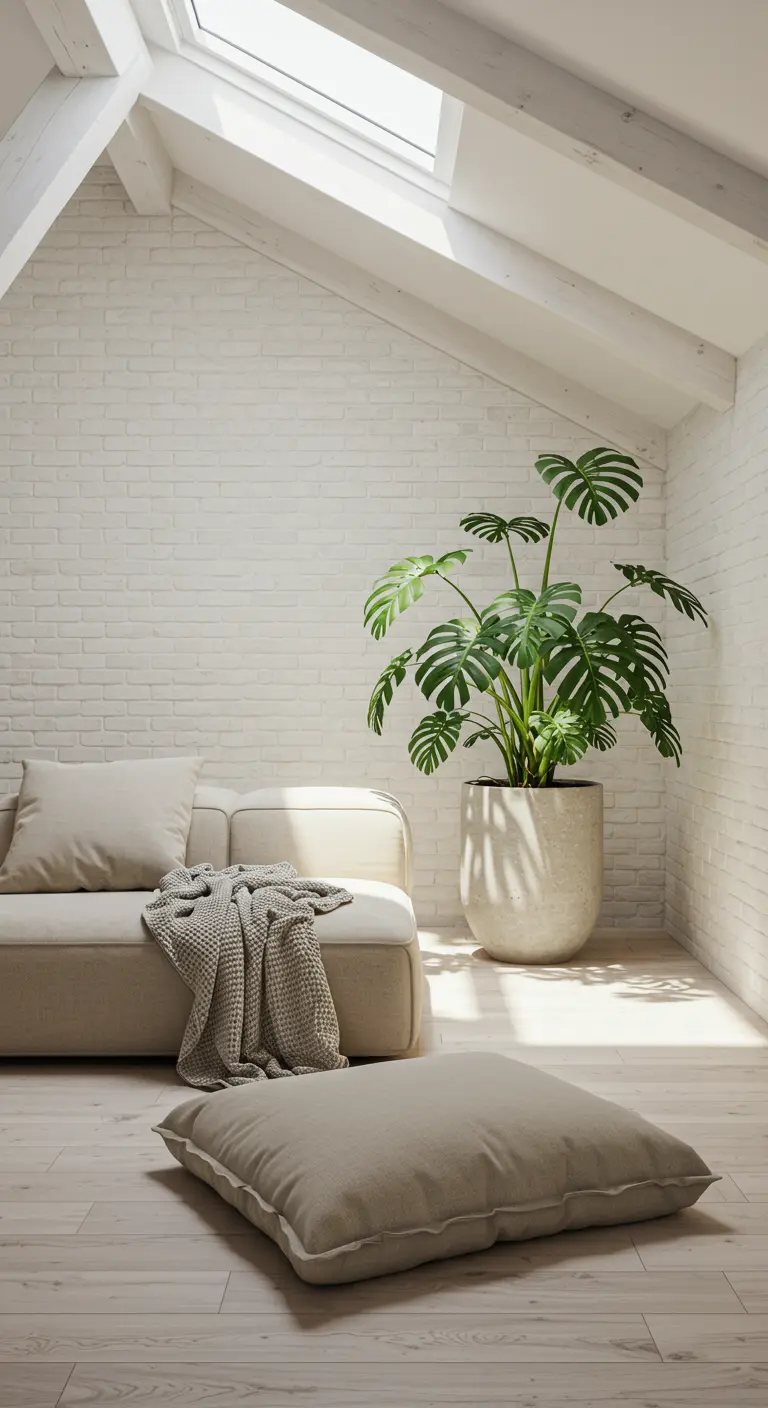
In a room with interesting architecture, such as an attic, paint everything—walls, ceiling, beams—the same shade of soft white.
This technique erases visual boundaries, making the space feel significantly larger and brighter.
The uninterrupted canvas allows the textures of the brick, the plant, and the textiles to become the main focus, adding character without complexity.
6. Create Drama with Sculptural Lighting and Stone
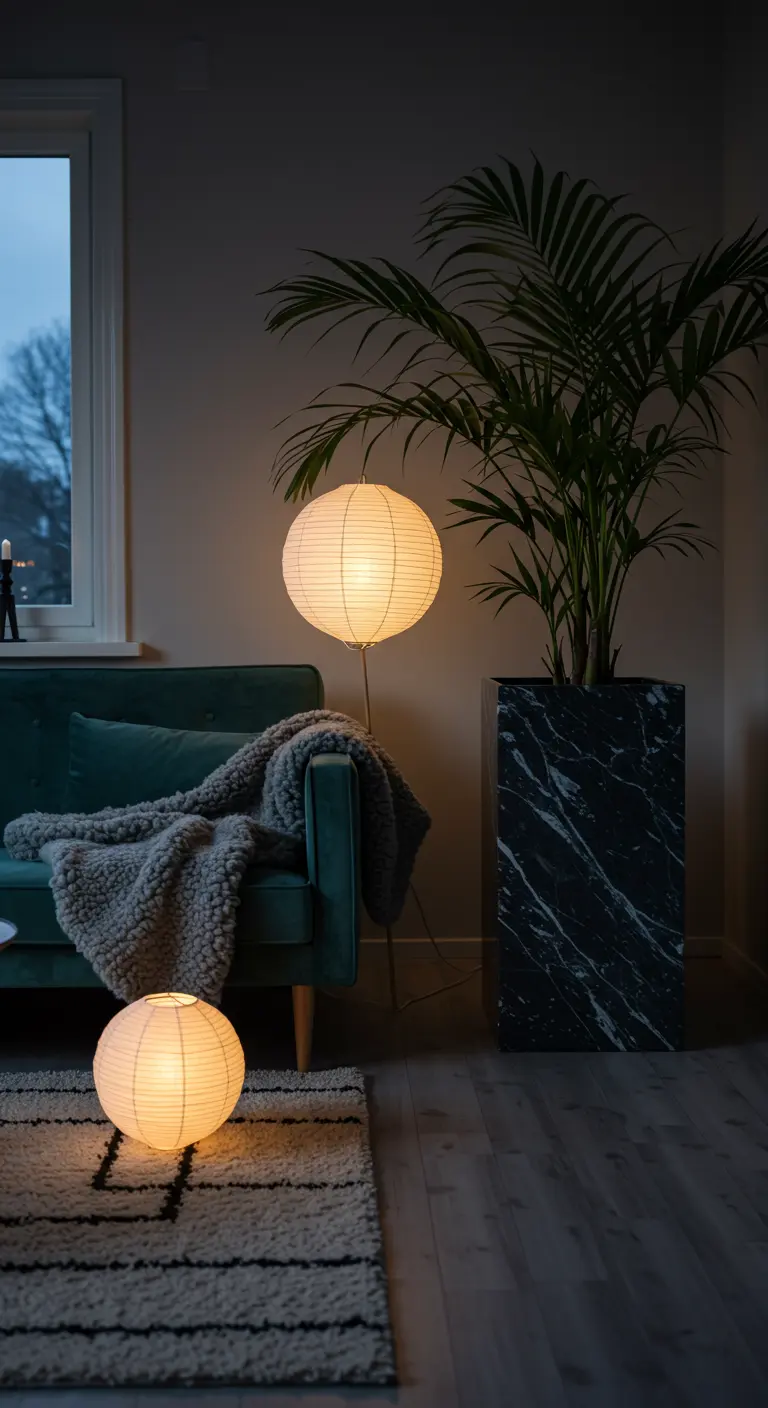
A spa-like feel doesn’t have to be exclusively light and bright. Introduce mood with a deep-hued velvet sofa and dramatic accents.
A tall, veined marble planter acts as a pedestal, elevating a simple palm into a sculptural statement.
Softly glowing paper lanterns provide ambient light that feels both modern and timeless, perfect for creating an intimate atmosphere.
This balance can also be applied to moody nighttime balconies.
7. Embrace Simplicity with a Single Focal Point
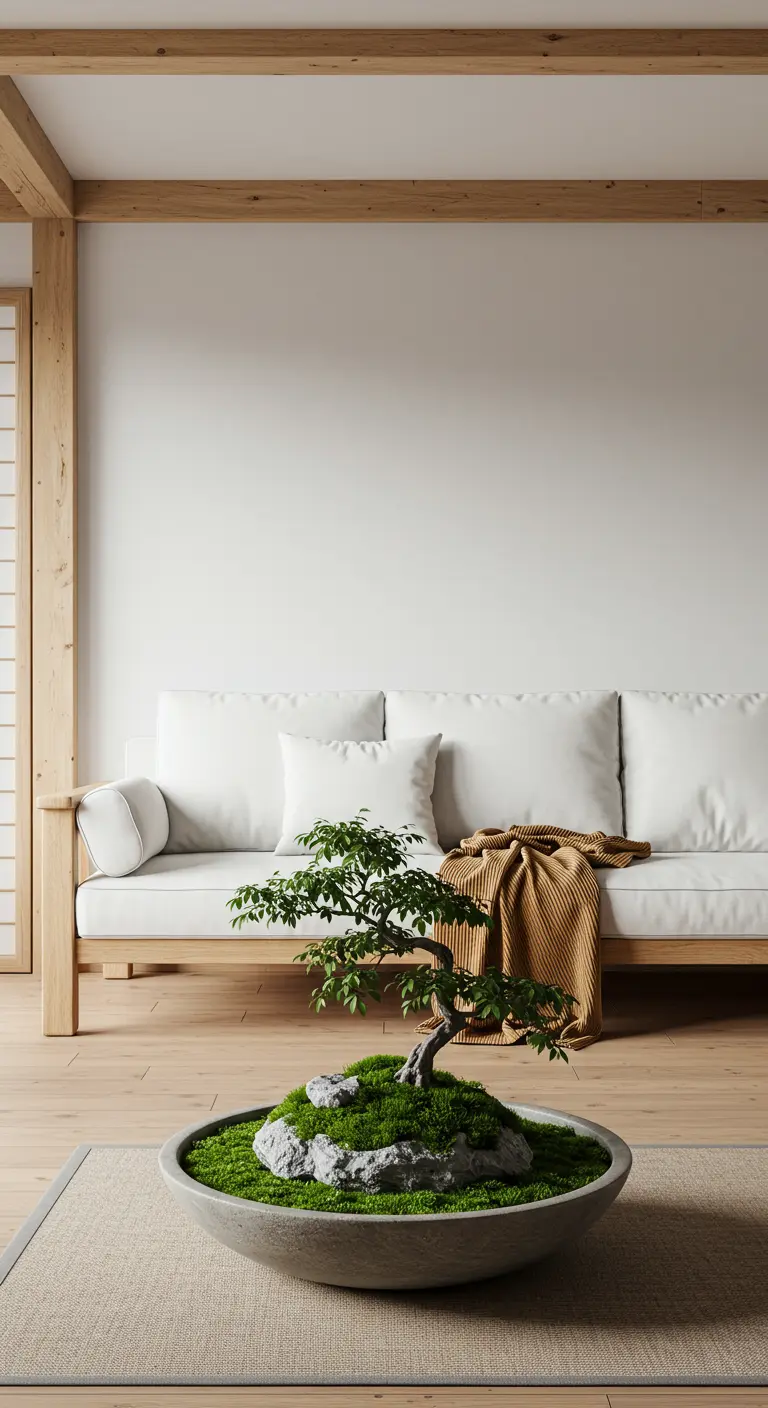
True serenity often comes from subtraction. Instead of multiple decor items, choose one object of profound beauty and give it space.
A meticulously cared-for bonsai in a shallow stone bowl becomes living art. It commands attention and sets a contemplative tone for the entire room.
This principle of focused minimalism is central to Japandi interior design.
8. Add Personality with an Artisanal Planter
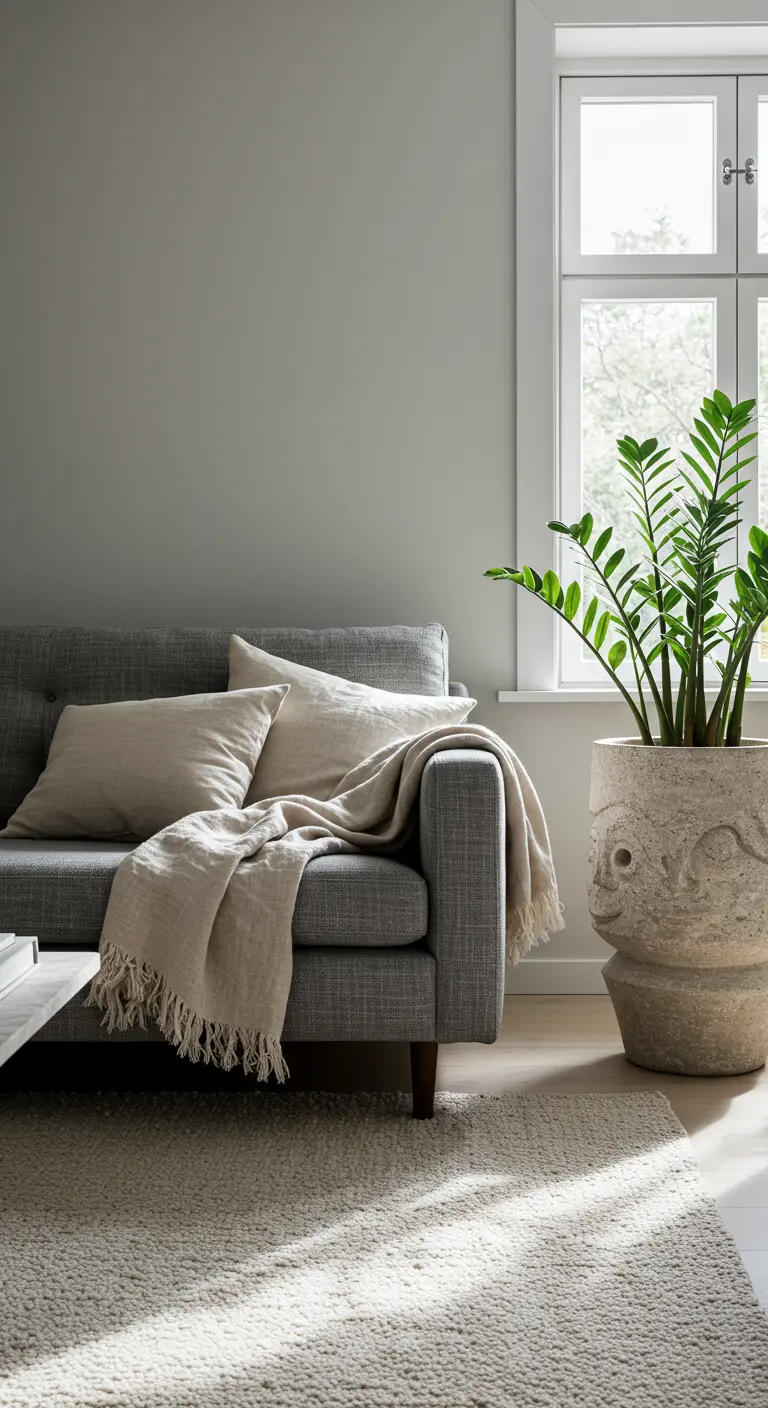
Move beyond standard pots and choose a planter with character and a sense of history.
This carved stone planter, with its subtle face motif, adds a touch of soul and prevents the space from feeling anonymous.
Paired with soft linen throws against a calm, sage green wall, it’s a masterclass in combining texture with personality.
9. Bring the Outdoors In with Grouped Planters
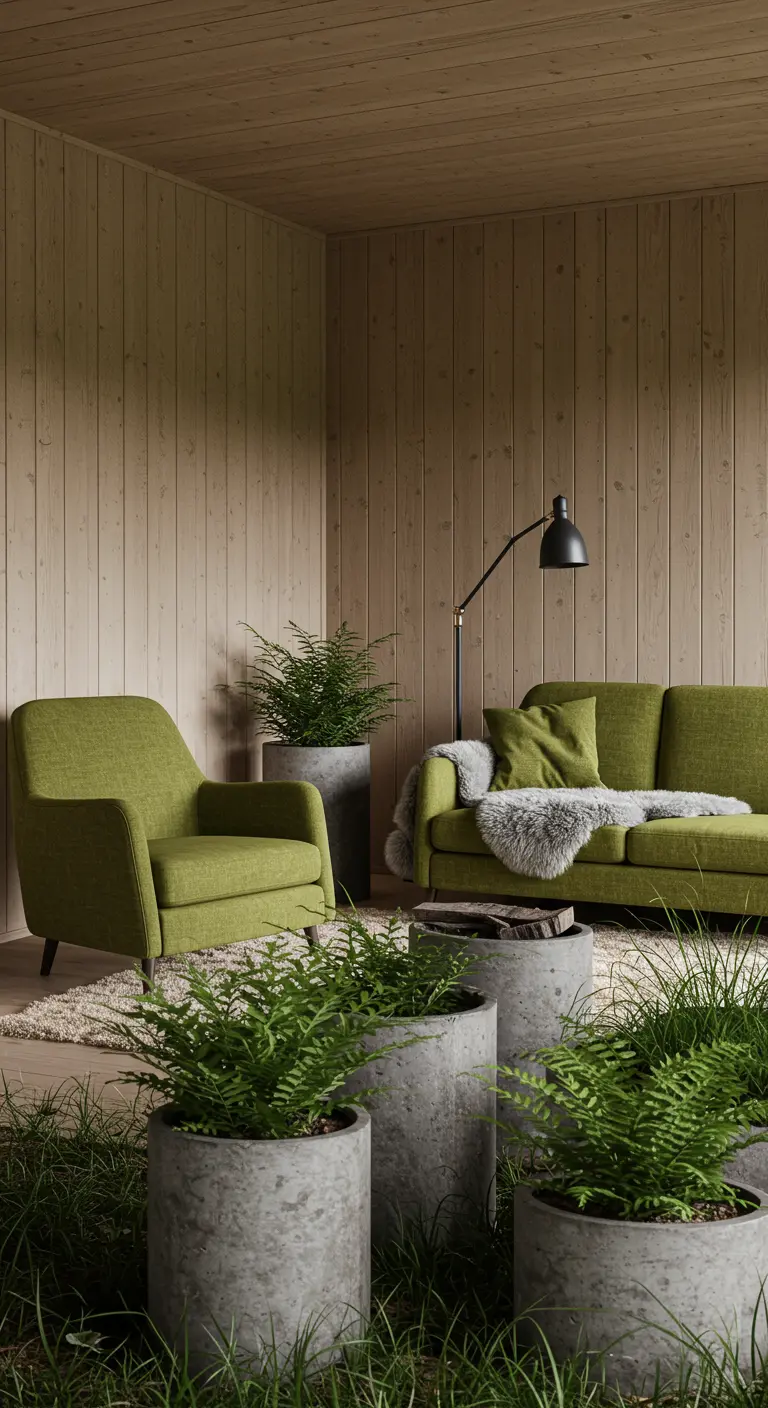
Create the feeling of an indoor garden by grouping several concrete planters of varying heights.
This arrangement mimics a natural landscape and makes a stronger visual statement than a single, isolated plant.
The cool gray of the concrete provides a perfect foil for the warmth of green upholstery and wood paneling.
This is a great technique for any nature-inspired small space.
10. Use High Contrast for a Modern Edge
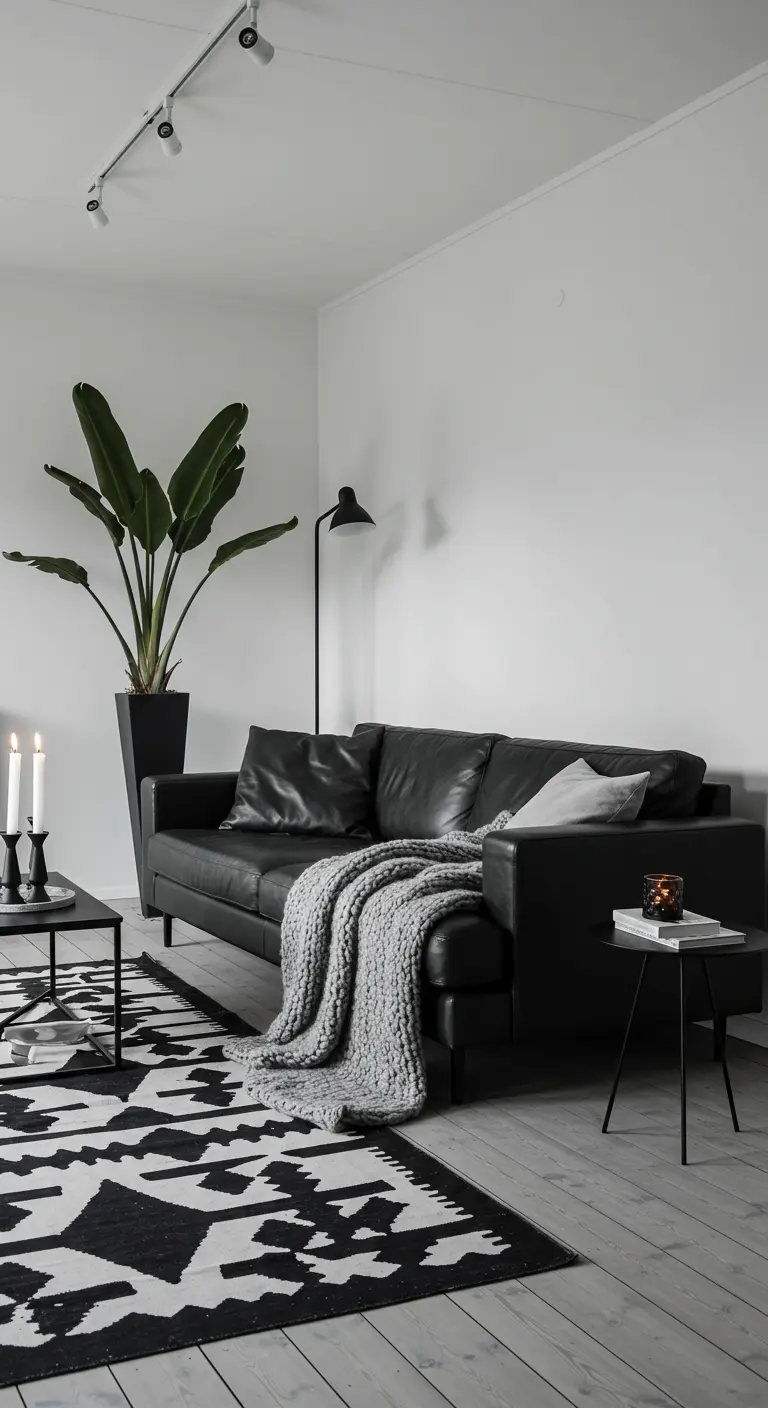
A Scandinavian aesthetic can also be bold and graphic. A black leather sofa paired with a high-contrast geometric rug creates a dynamic, modern foundation.
The key to keeping it serene is to keep everything else minimal: crisp white walls, a slim floor lamp, and a single, tall plant in a sleek black planter.
A chunky knit throw in a soft gray softens the look just enough.
11. Master the Art of Tone-on-Tone Texture
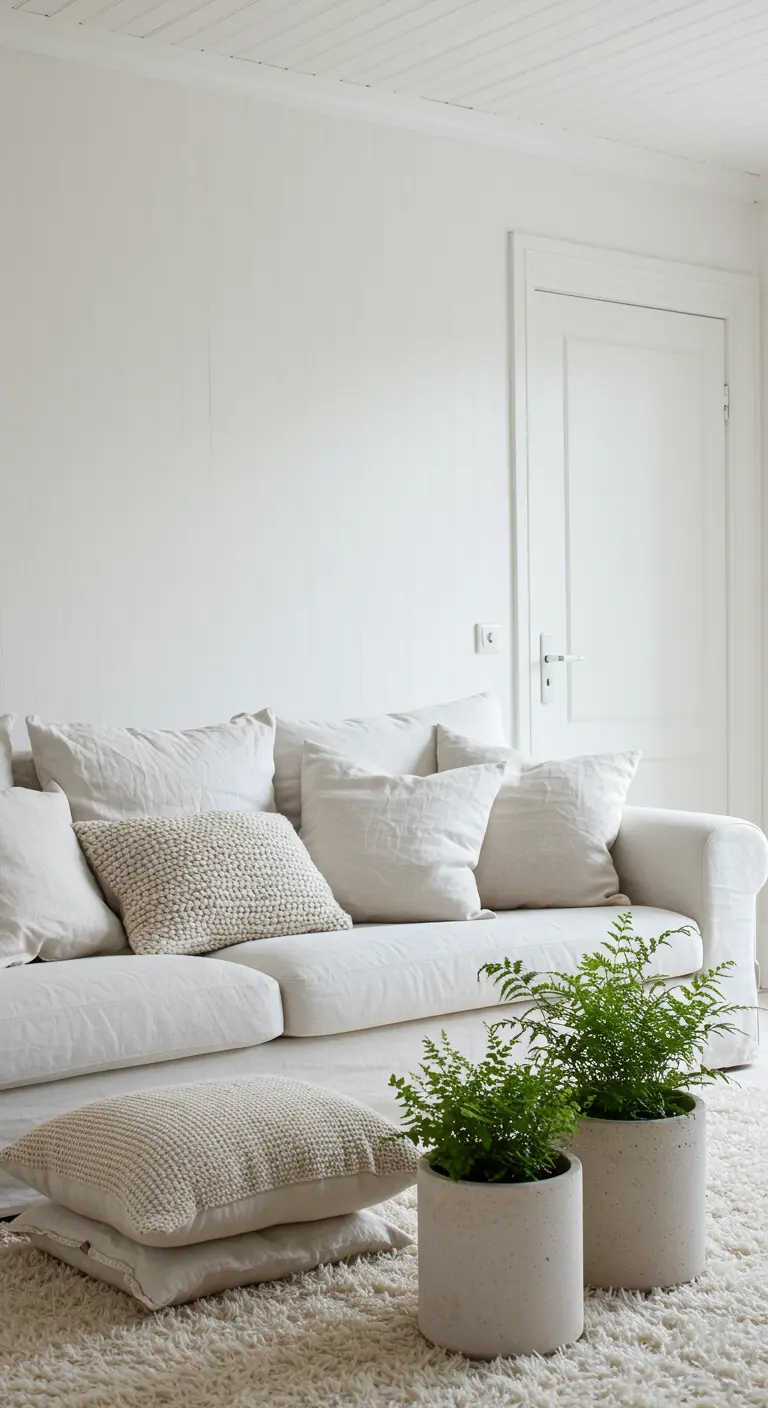
An all-white room becomes serene, not sterile, when you layer multiple textures.
Combine a deep-pile shag rug, wrinkled linen slipcovers, and nubby knit pillows. The subtle variations in texture create depth and invite touch.
The smooth, cool concrete of the planters provides the perfect counterpoint to all that softness, creating a balanced sensory experience.
12. Introduce Warmth with Terracotta and Textiles
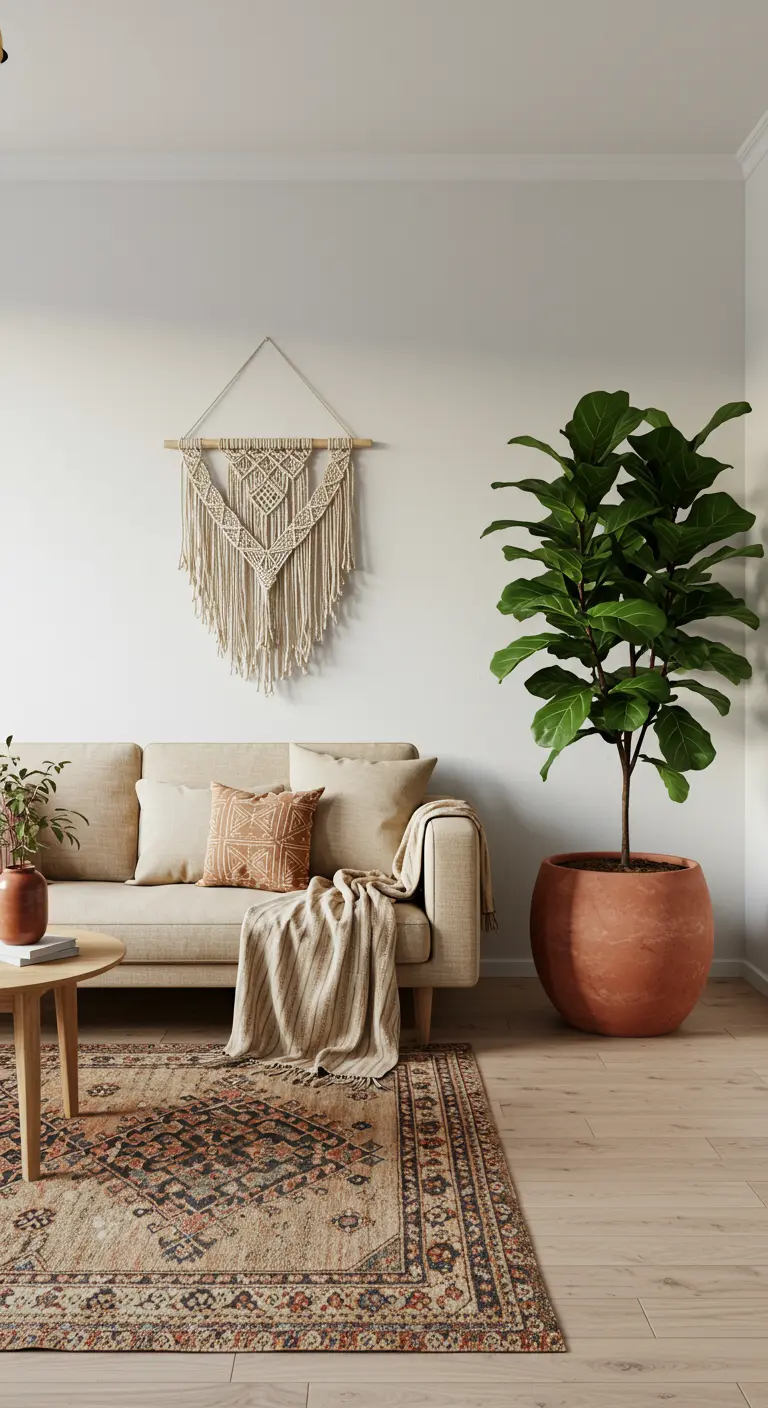
To warm up a neutral Scandinavian base, introduce earthy materials that feel connected to the earth.
A large terracotta planter adds a soft, rustic warmth that feels timeless. Echo that handmade quality with a macrame wall hanging.
These elements shift the aesthetic from purely cool Scandi to a more relaxed, bohemian vibe, reminiscent of desert-inspired interiors.
13. Pair a Modern Fireplace with a Raw Planter
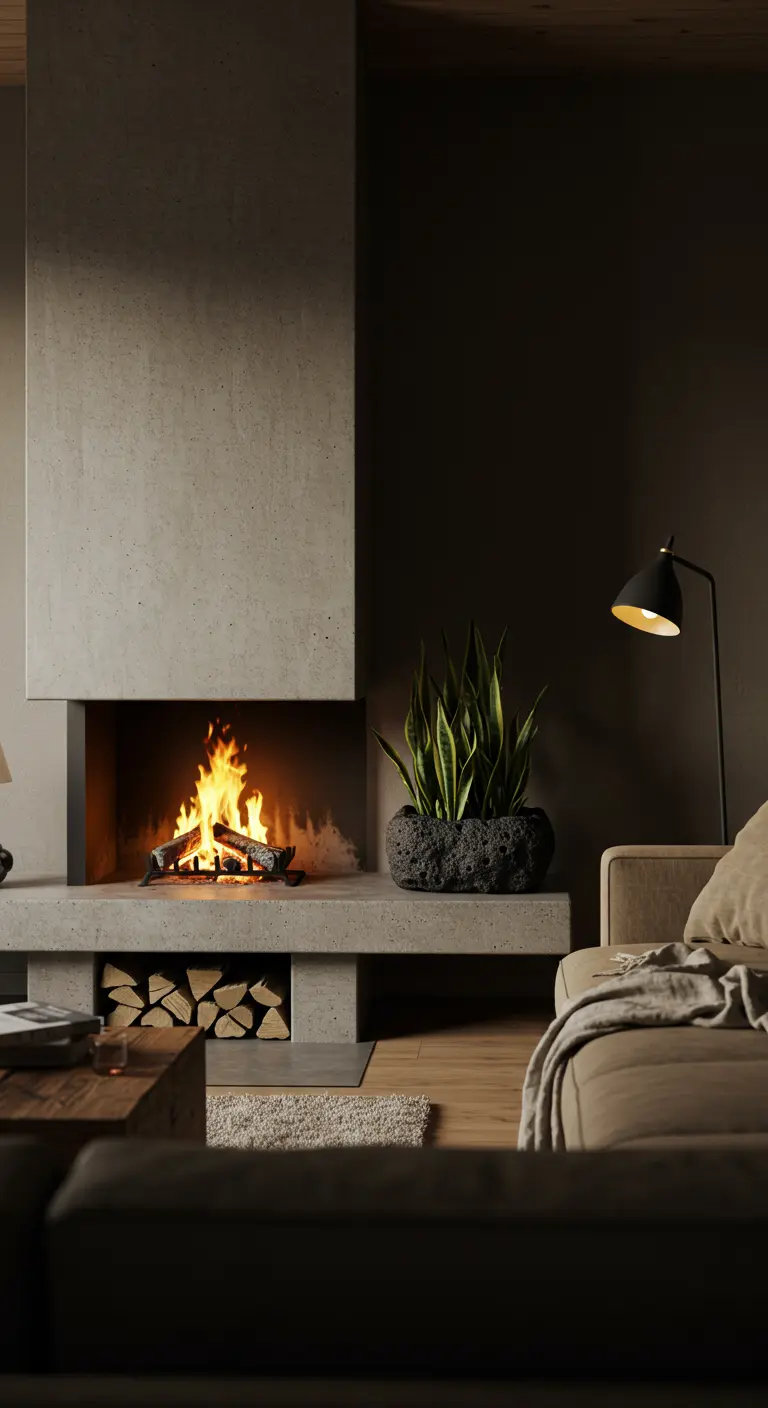
A minimalist concrete fireplace is a powerful architectural statement. Soften its hard lines without compromising the aesthetic by adding a planter with organic, raw texture.
A porous lava rock planter is an excellent choice, as its dark, rugged surface complements the smooth concrete and echoes the natural essence of fire and stone.
This is how you create balance with modern rustic hybrids.
14. Soften Lines with Curves and Hanging Greenery
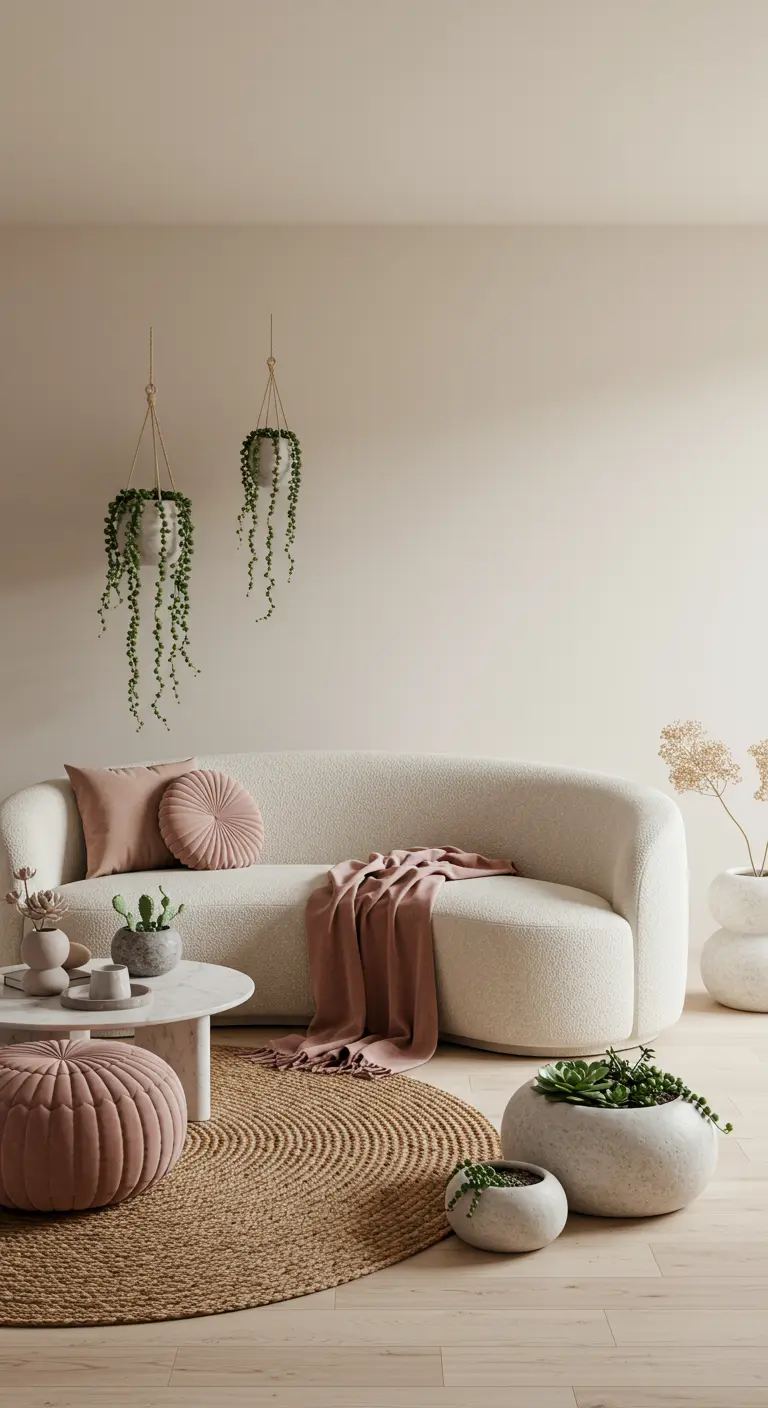
If your goal is a soft, nurturing space, move away from sharp angles in your main furniture pieces.
A curved bouclé sofa immediately feels welcoming and gentle. Enhance this effect with rounded pillows and stone planters.
Hanging plants draw the eye upward, adding a layer of delicate, trailing life that softens the entire room.
This approach can transform a room into an ethereal pastel dream.
15. Use Large Planters to Frame a Zone

In an open-concept space, use two identical, large-scale planters to create a visual gateway.
Placing them on either side of a seating area helps define the space without closing it off.
This technique adds symmetry and a sense of intention, guiding the eye and framing the living area as a distinct, purposeful zone.
16. Match Wood Tones for a Cohesive Shell

For an immersive, cabin-like feel, use the same light wood for flooring, wall paneling, and furniture frames.
This creates a seamless, harmonious shell that is incredibly calming and restful on the eye.
Against this unified backdrop, simple white cushions, a green waffle-knit throw, and a trailing plant provide all the color and texture needed.
These are the kinds of details that make Scandinavian winter retreats so inviting.
17. Elevate Greenery with a Hanging Planter
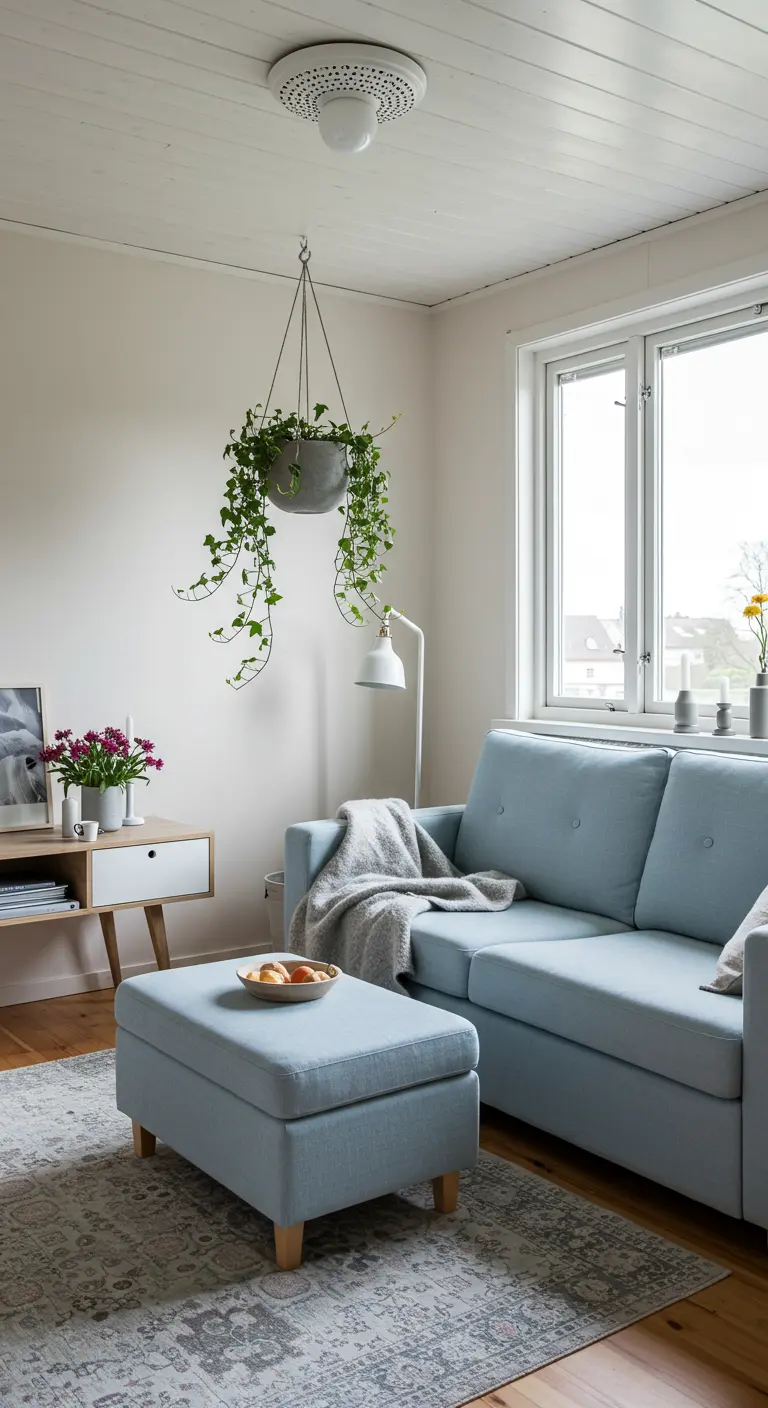
In a smaller room, a hanging planter is a brilliant solution for adding life without taking up precious floor space.
It draws the eye upward, creating an illusion of height and adding a dynamic, sculptural element to the room.
Suspend it in a corner near a window where it can catch the light and create beautiful, shifting patterns.
This clever use of vertical space is perfect for decorating a tiny entryway.
18. Use Strategic Lighting in a Dark Space
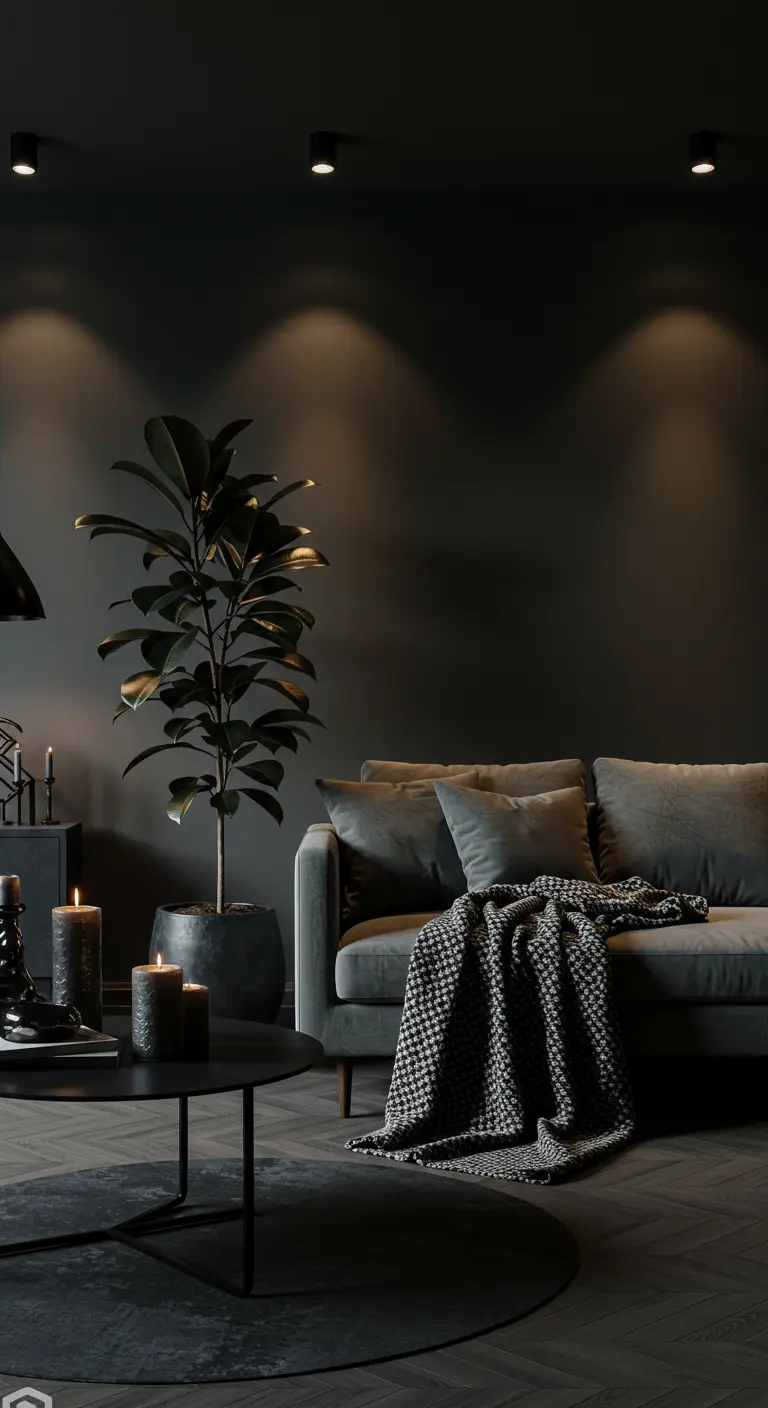
To create a dramatic, enveloping atmosphere, paint your walls a deep charcoal or black.
The key to making this work is precise lighting. Use track lighting or spotlights to wash the walls with light and highlight specific areas, like a plant or a seating arrangement.
This creates pools of intimacy and prevents the room from feeling oppressive, instead making it feel like a cozy cocoon.
19. Add an Artisanal Stool as a Side Table
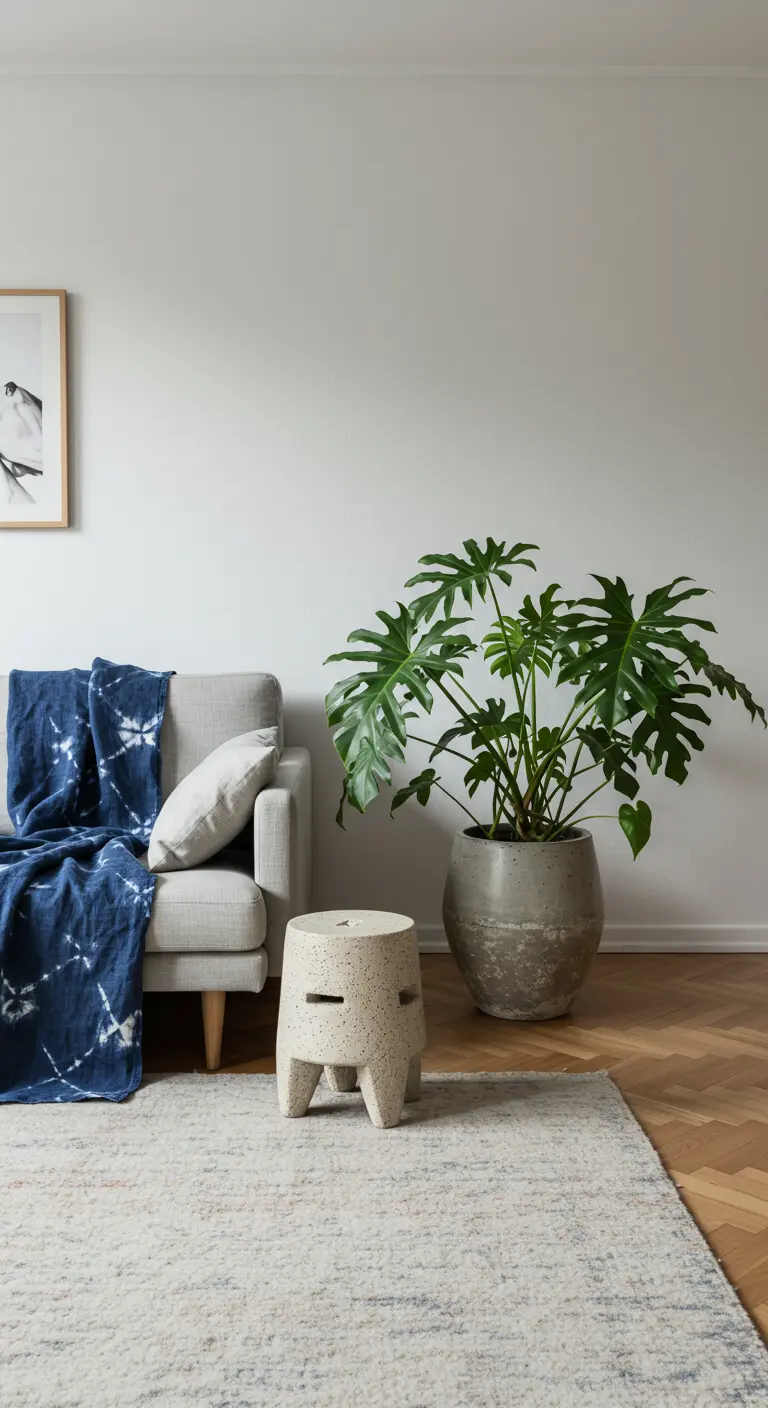
Instead of a traditional side table, consider a sculptural, primitive-style stool.
This terrazzo or stone piece adds an earthy, wabi-sabi element that feels both ancient and modern—a functional piece of art.
The deep indigo of the shibori-dyed throw provides a rich, organic color contrast against the neutral gray and white.
20. Go Industrial with a Corrugated Metal Planter

Don’t be afraid to introduce industrial materials into your serene space. They can add fascinating texture.
A long, corrugated galvanized steel planter acts as a unique room divider and provides an unexpected textural element.
It works especially well against concrete walls and floors, while the vibrant green of the snake plants provides a perfect organic contrast.
It’s an idea borrowed from industrial boho balconies.
21. Create a Cozy Nook with Stacked Textiles
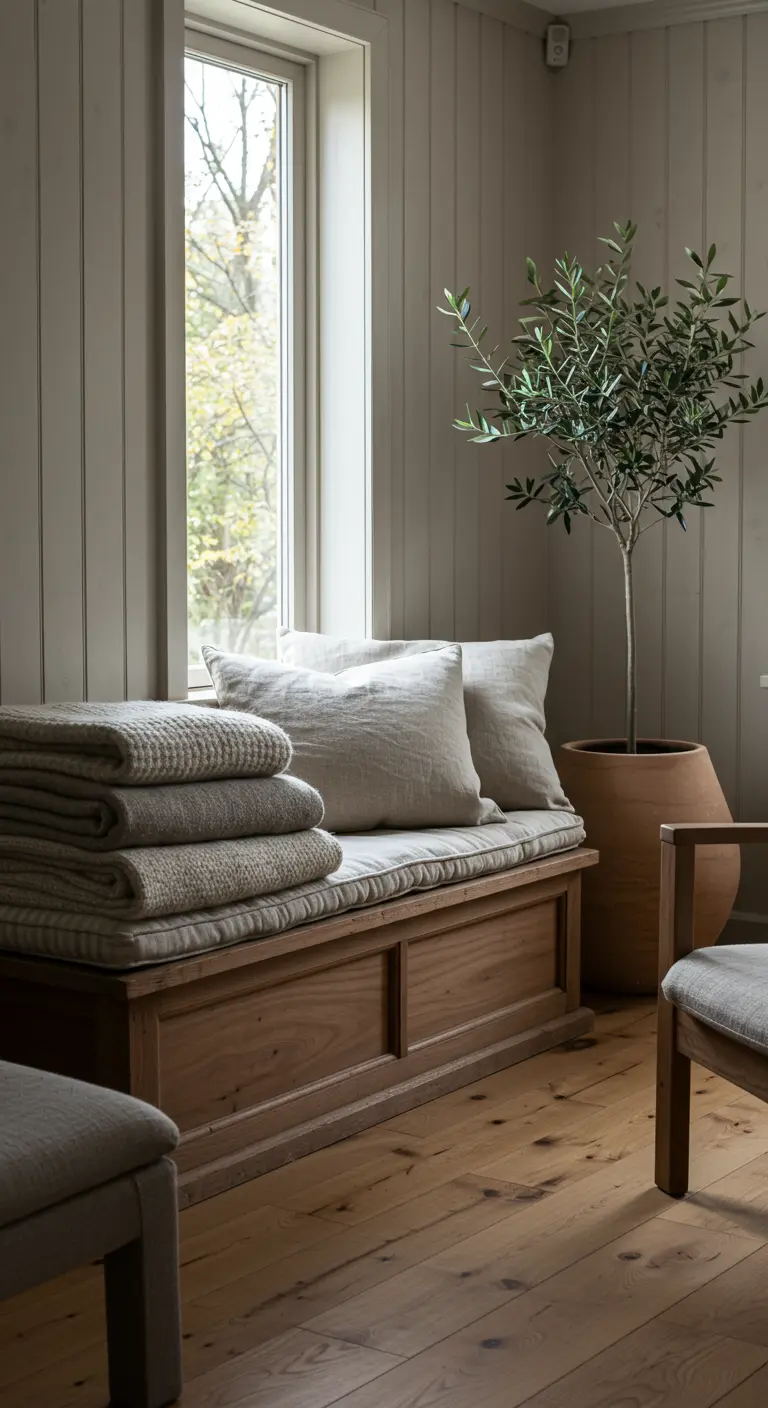
Turn a simple window bench into an irresistible retreat by focusing on lavish texture.
Layer a striped cushion with a generous stack of thick, soft wool blankets in complementary neutral shades.
The visible texture is an open invitation to get comfortable. Placing a tall olive tree in a terracotta pot nearby connects the cozy nook to the view outside.
22. Anchor the Room with Sculptural Coffee Tables

Instead of a single, large coffee table, try grouping two smaller, sculptural tables.
These concrete pieces feel solid and grounded, like stones on a shore. Their smooth, cool surface is the perfect balance for a plush sofa piled high with soft linen and knit throws.
The rounded shape encourages flow and conversation, making the space more interactive.
Similar sculptural elements define sophisticated balcony gardens.
23. Punctuate White with Graphic Black
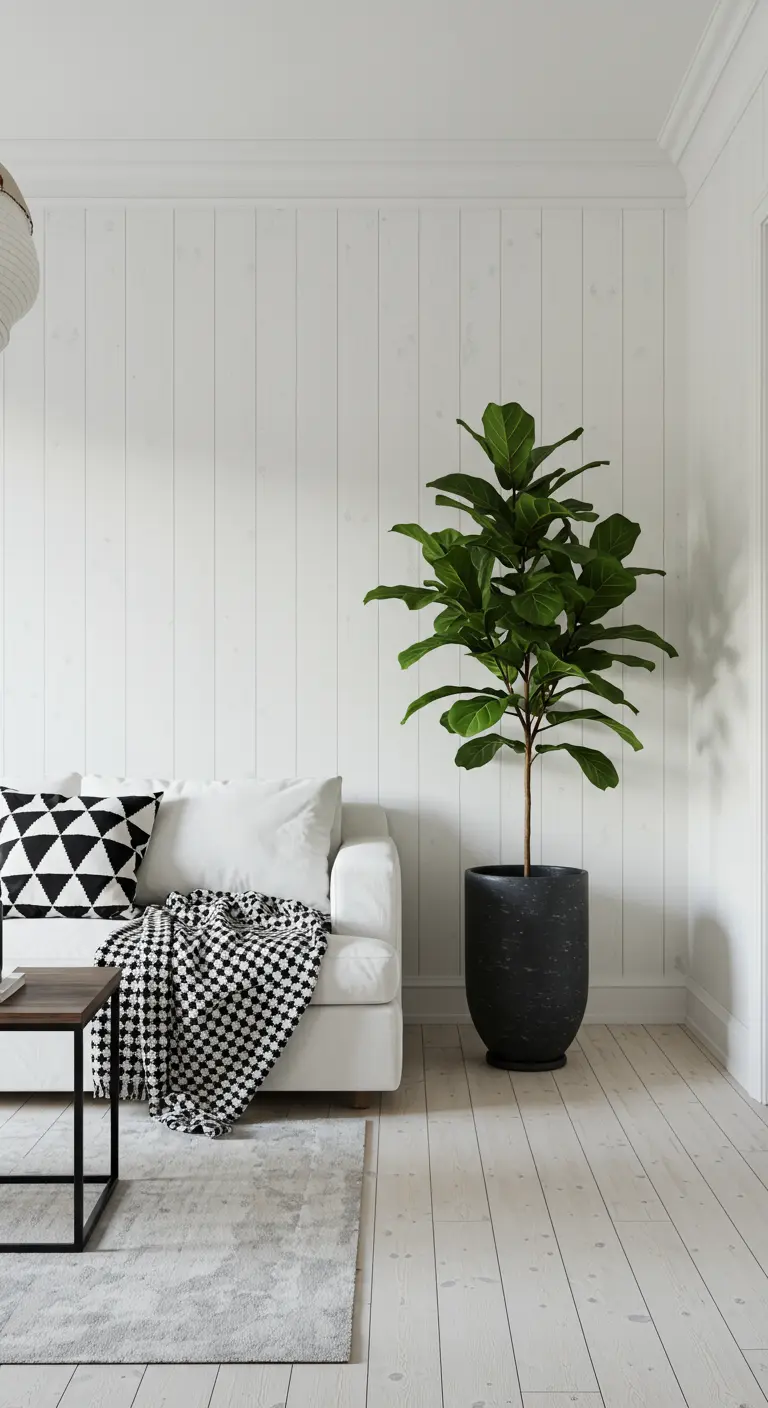
A crisp, white room with vertical shiplap provides a clean and textured canvas.
Introduce small, deliberate pops of black to create visual punctuation and a sophisticated edge.
A geometric black-and-white pillow and a checkerboard throw are just enough to add graphic interest without disrupting the calm. A black planter further grounds the look.
24. Evoke a Countryside Feel with Plaid and Lavender

For a Scandi-inspired look with a touch of rustic charm, introduce classic patterns and fragrant plants.
A soft plaid throw in muted gray tones feels instantly cozy and familiar.
Pairing it with weathered stone and galvanized metal planters filled with lavender adds a sensory layer—it looks and smells like a peaceful country garden.
This style is reminiscent of Country French kitchens.
25. Use a Tall Plant to Create Separation
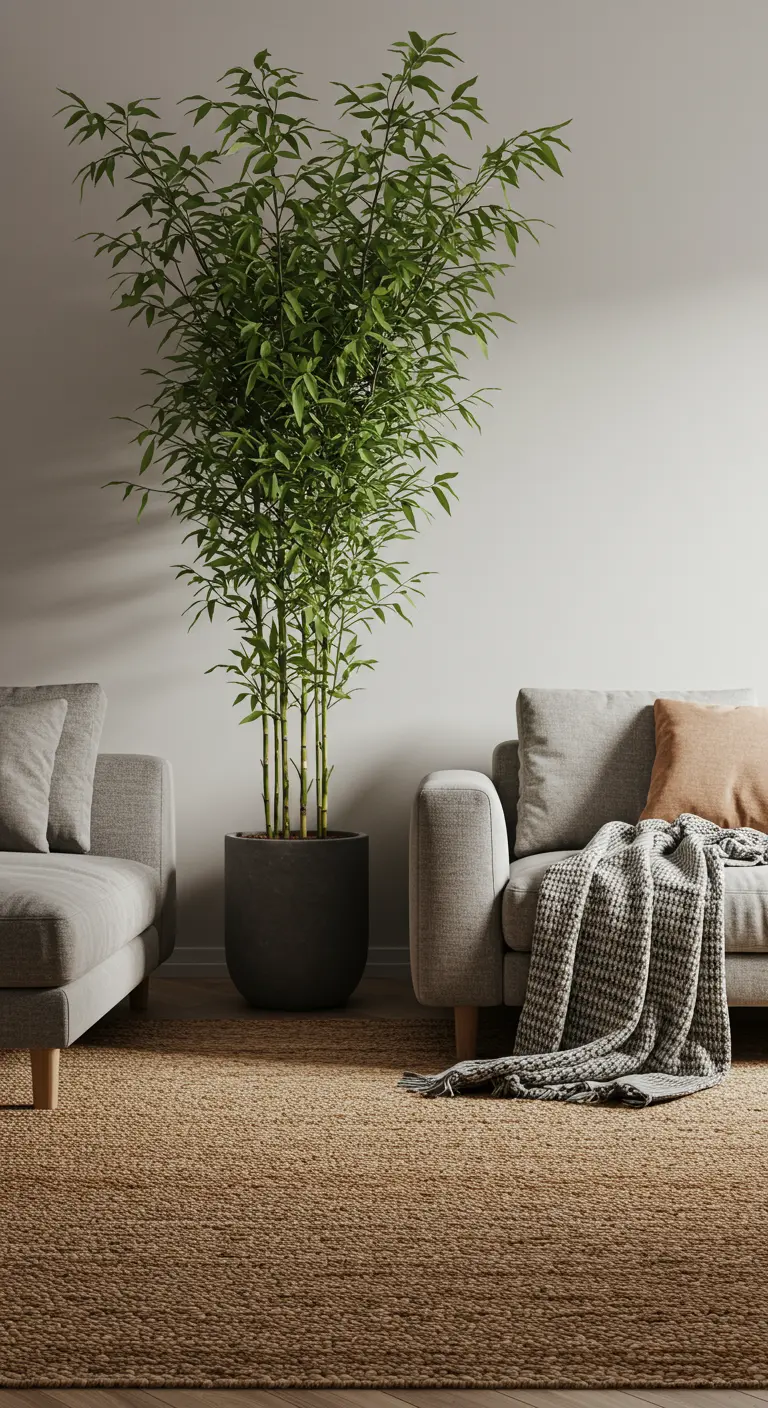
When you have two sofas or a large seating area, a tall, slender plant can act as a subtle and beautiful divider.
A bamboo plant in a simple dark planter adds verticality and a sense of life, defining the space between the two seating elements without a heavy visual barrier.
It maintains the open, airy feeling of the room while creating distinct zones.
26. Appreciate the Beauty of Shifting Light
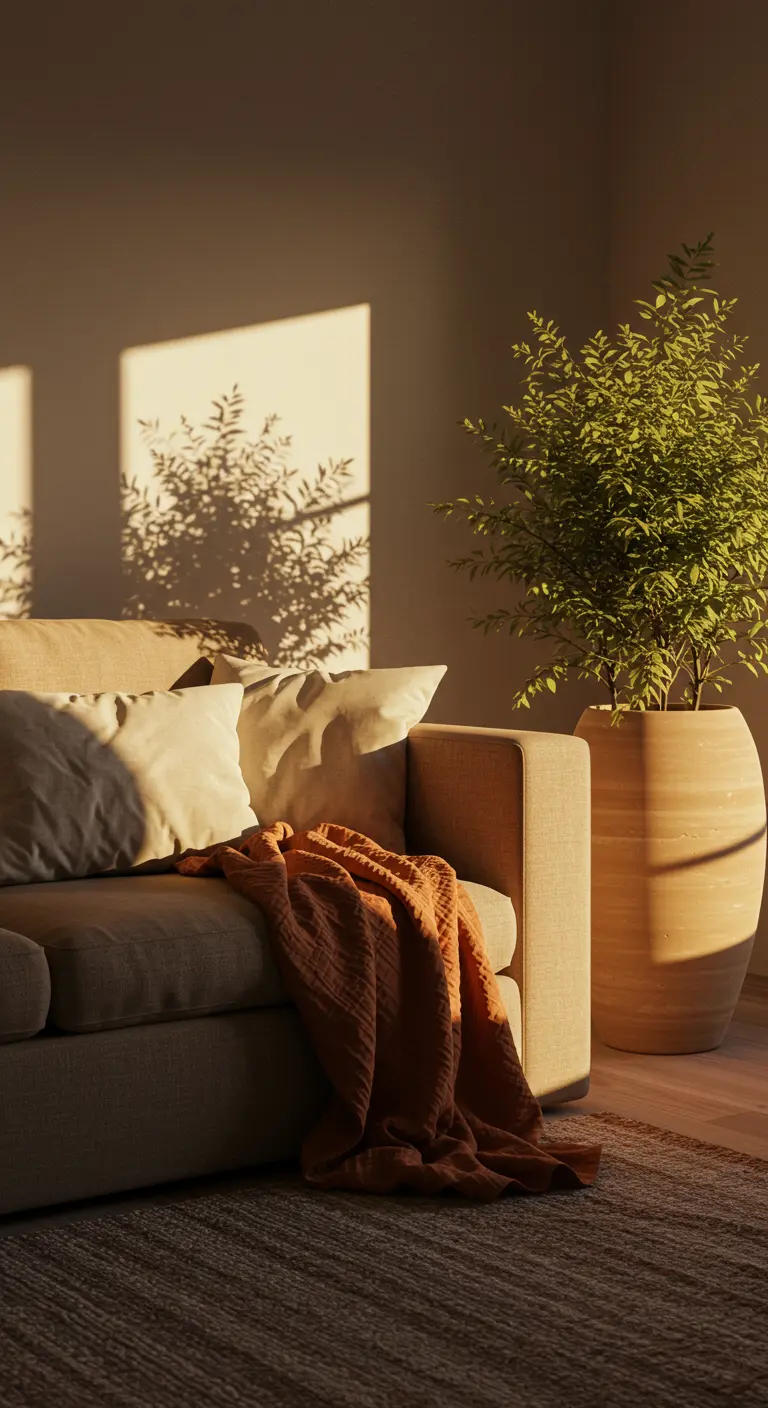
Sometimes the most powerful design element is free: natural light.
Position a plant where its leaves will cast dramatic, shifting shadows on the wall throughout the day. This turns a plain wall into a dynamic canvas of moving art.
An earthy terracotta throw and planter enhance the warm, sun-drenched feeling.
You can see a similar effect in these sun-drenched rustic patios.
27. Balance Softness with Raw, Solid Wood
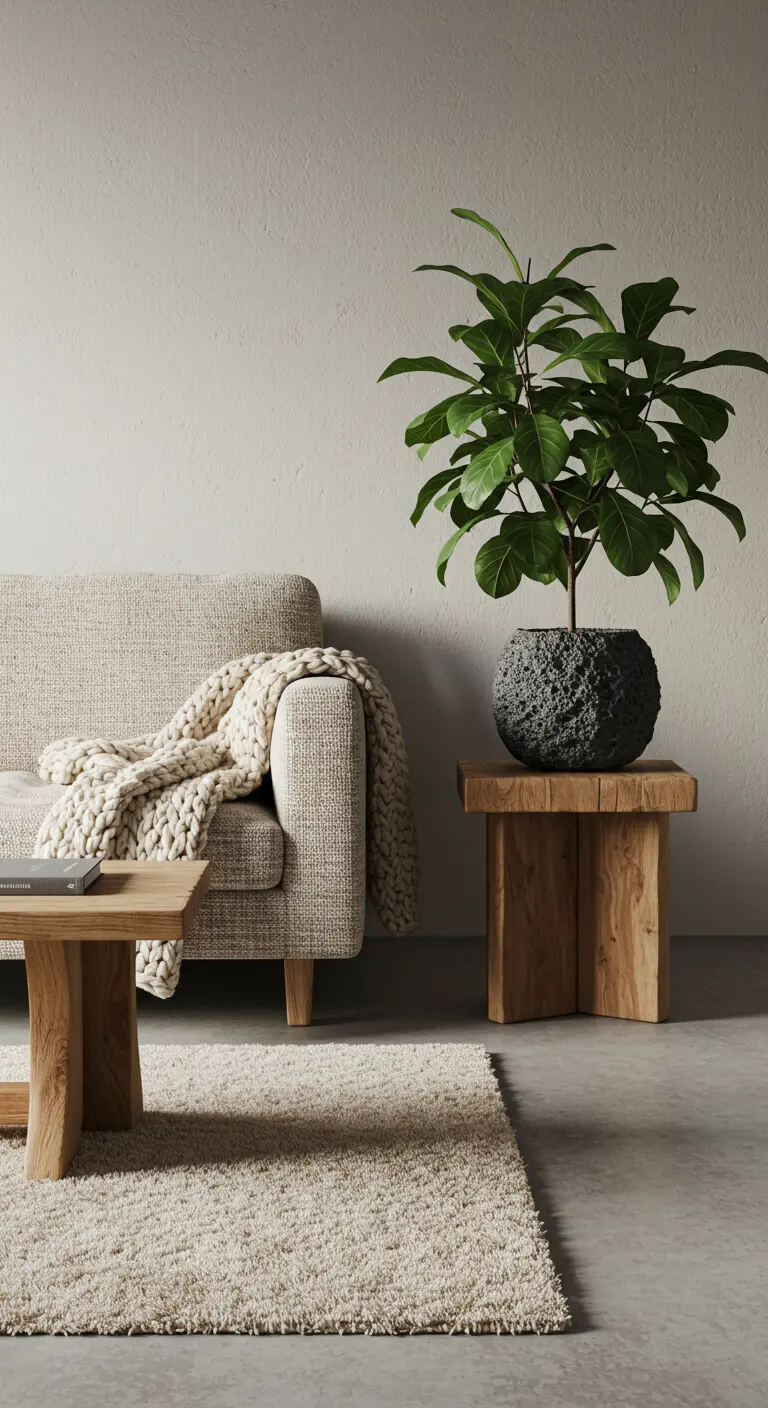
The soft, nubby texture of a bouclé sofa or a heavy-knit throw needs a strong counterpoint to feel grounded.
A side table made from a solid, rustic block of wood provides that essential balance.
The contrast between the yielding textile and the unshakeable wood is deeply satisfying and adds a layer of organic strength to the room.
28. Combine Fluting and Velvet for Understated Luxury
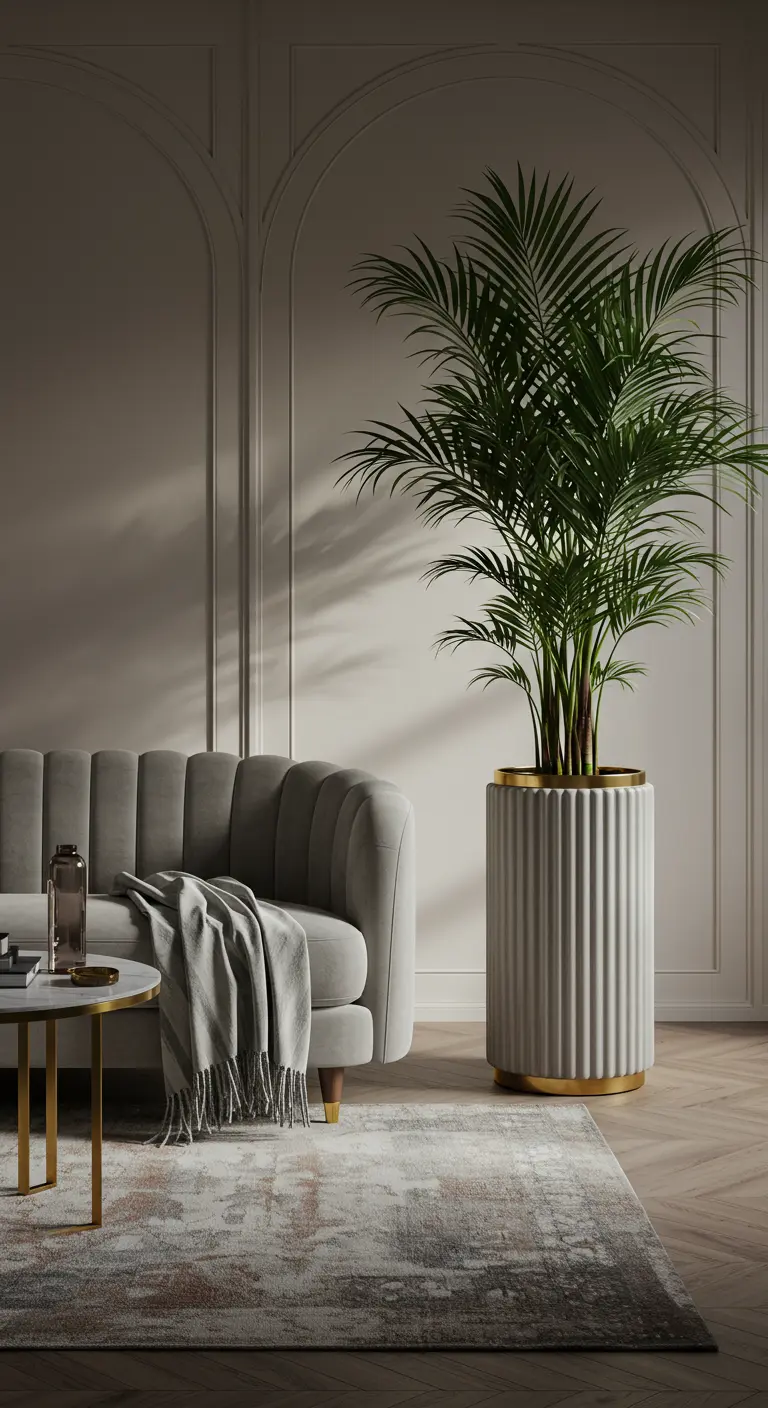
To achieve a look of quiet luxury, focus on sophisticated textures that speak to each other.
A channel-tufted velvet sofa has a classic elegance that pairs beautifully with a fluted planter. The repetition of vertical lines creates a subtle, calming rhythm.
A touch of brass at the planter’s base adds a final note of warmth and polish.
These details are key to creating transitional modern spaces.
29. Ground a Low Bed with a Heavy Stone Planter
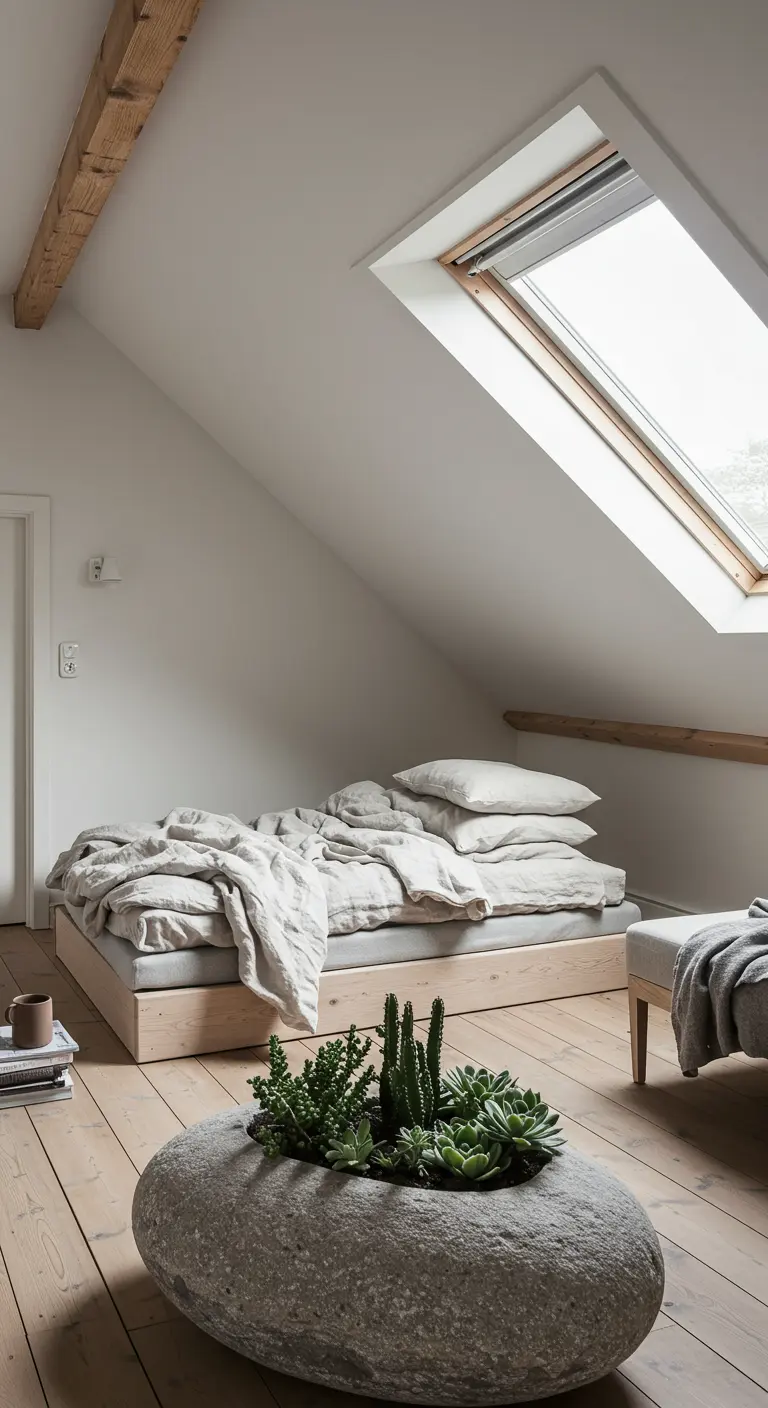
A low-profile platform bed creates a grounded, Zen-like feeling, perfect for a restful bedroom.
Amplify this by placing a large, heavy, and low-slung stone planter nearby. This one, shaped like a natural river stone and filled with succulents, acts as a sculptural anchor.
It keeps the energy of the room low and calm. It’s an idea borrowed from the tranquility of a contemporary Zen home.
30. Layer Earth Tones for a Natural Palette

Move beyond a simple beige or gray by layering a family of rich earth tones.
An olive green sofa provides a sophisticated base. Add warmth with pillows in rust and burnt orange, and a cozy throw in a similar shade.
A rough-hewn stone coffee table completes the nature-inspired palette, making the space feel deeply connected to the outdoors.
Explore more warm earth tone rooms for inspiration.
31. Celebrate the Beauty of Simple Forms
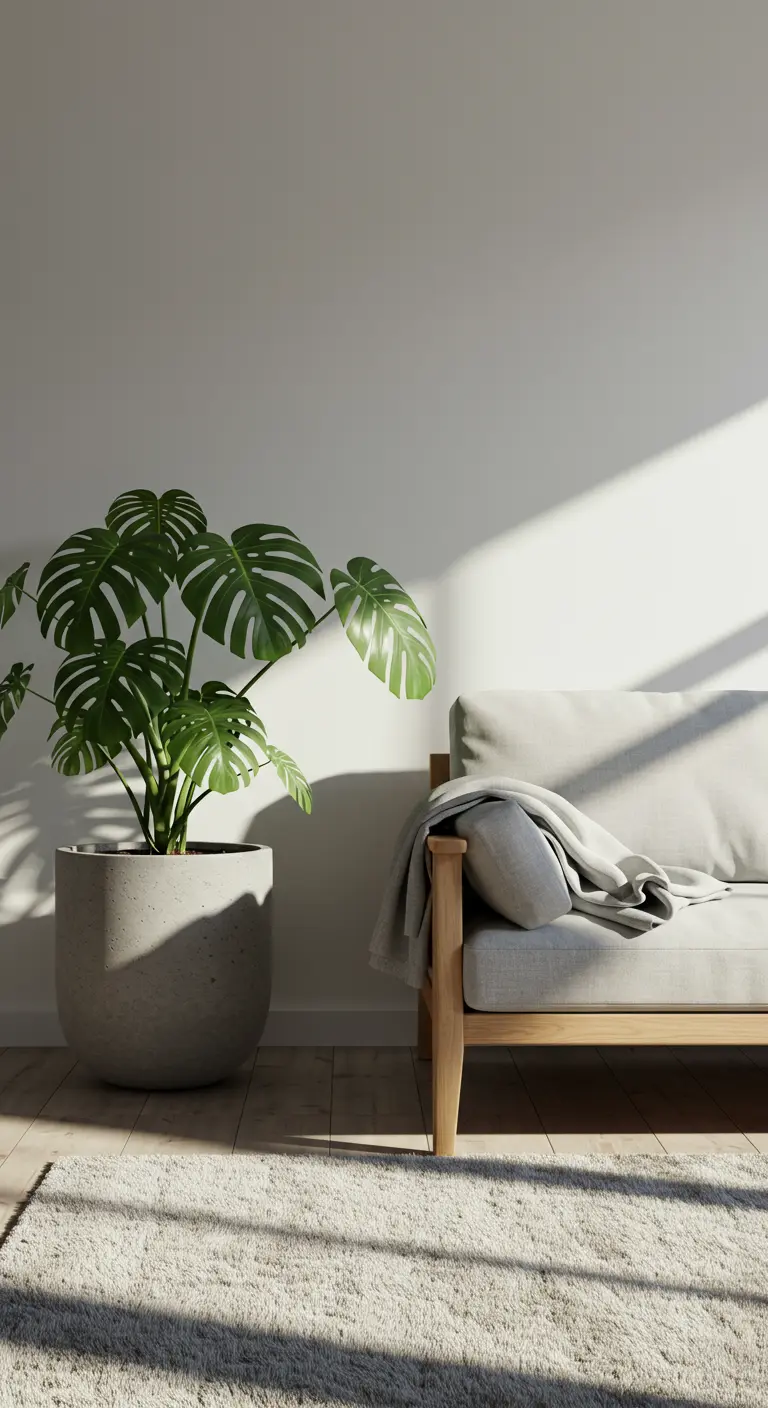
You don’t need complex furniture to create a beautiful, serene space. The clean lines of a simple, Scandinavian-style wood-frame sofa are timeless.
Let its elegant form shine by pairing it with other honest materials: a plain concrete planter, a soft wool rug, and a simple linen throw.
This is serenity in its purest, most confident form—nothing to add, nothing to take away.

